The Earthworm Gathering Part Two – A Personal Coat Of Arms
The Earthworm Gathering Part Two – A Personal Coat Of Arms
Story and photos by Alastair Thompson
Scoop’s ex-founder Alastair Thompson was the Kiwi member of the Earthworm team. In a five part series he is telling the story of the inaugural Earthworm Gathering for Faithful Diggers (held 26th-30th June near Cogne Italy). In part one he set the scene for the gathering. Today he writes about the first day, during which he and his fellow diggers learned about the art of duck divination and created a personal coat of arms.
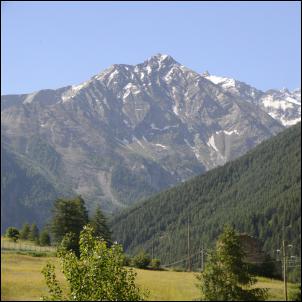
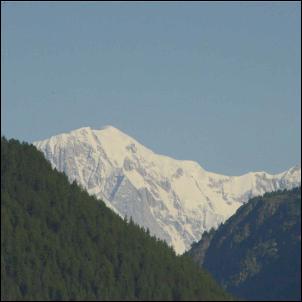
The views from Plan de la Tour in Epinel where the gathering was held: (left) up the valley towards the village of Cogne; and (right) down the valley towards France and Mt Blanc.
"In these cases (and many more), the power for change [for organisations] came from within, from deeply held values that had in some way been questioned or challenged. The overriding feeling that resulted, was a passionate ‘This is not who we are!’ That exasperation in turn triggered very serious and determined action." – Scott Poynton from his e-book about the VT-TV process Beyond Certification.
A stunning day
We commenced the work we had gathered for in our beautiful environs on Monday 27th June 2016 after breakfast in Letizia's Plan de la Tour dining room. The room featured giant windows with views of the mountains across and up the valley. The faithful diggers gathered around four smallish tables arranged in a semi-circle facing two flip-boards.
Through the windows we could see Punta Pousset in the middle of the range, framed by a deep blue sky. It was a stunning day. On the summit of this peak two days earlier Cogne native Imer had been struck by lightning. As I looked at its steep slopes I kept thinking how amazing it was that a seriously injured young man had been able to run down such a large mountain after being struck on the head by lightning. Later in the week we would meet him, but at that moment we had no idea how he was, only that he was in hospital in Milan.
I was the last to arrive for breakfast, needing to catch up on some sleep deprivation occasioned by watching the Brexit vote through the night the previous Friday morning. Scott Poynton greeted me as I arrived with gusto, "Ladies and Gentleman, Alastair Thompson." I sat down to a lovely breakfast of fruit and fresh, farm made, alpine yoghurt.
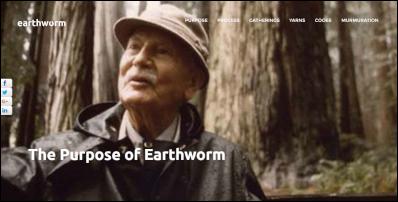
Earthworm.net's Purpose page (presently on hiatus) features an image of Richard St Barbe Baker, a major inspiration for the project and its founders.
Earthworm as a story sharing adventure
"Earthworm is a learning community to help us change ourselves and change our world. The art of gentle revolution." The page explains why Julien and Scott decided to do this in the form of a sharing story adventure in the following words.
"At the very heart of this gentle revolution is the simple and ancient act of story sharing.Earthworm lives within TFT, where over the past 17 years we’ve grappled with environmental and social issues, big and small, in forests, plantations, quarries, factories, farms, in cities, in remote rural backwaters, in work places around the world. Through this work we have developed a unique change process and numerous case studies of change that inform the Earthworm learning spaces.
We’ve also learned that change happens best when people engage together as people, as who they really are. Not as an NGO rep, not as a company rep, not as a Government rep, neither as expert nor as someone who needs educating. When people engage as human beings, we not only make progress but we can, together, effectively tackle problems we had long thought intractable.
Time and time again we’ve seen that most often, and most effectively, people find their common humanity and common ground through personal stories. Exchanging stories has the power to plant seeds of trust, innovation and new ways of being."
And today, here in the Italian Alps, the first foray on that story sharing adventure is about to start.

Our working space
Our adventure begins
After breakfast the learning phase of the gathering begins with an explanation from Scott and Julien about the work we are going to do over our four days together. They quickly get to the point. We are here for a story sharing adventure - we will be learning through listening to each others stories of change - while following the frame of TFT's VT-TV process supported by inspiration and facilitation from Scott and Julien.
- Day one will be about Values and answering the question: What do I stand for?
- On day two we will look at Transparency and explore two questions: 1. What is my impact today? and, 2. What is holding me back from having a more positive impact?
- Day three will be about Transformation: How can I change?
- And then before we lave we will consider the issue of Verification: What are the things that sustain us and how can we get honest feedback from critical friends?
Julien also explained we will be looking into the places in-between. The spaces between the mythical and the real, reflection and action, love and power, personal and professional. Ultimately our objective would be to bring these aspects of our lives better into alignment to enable us to be more true to ourselves, both in life and in work.
And then the story sharing began.
Early on in his career Scott had been working in Nepal. One day in the street a small chap had grabbed his hand and proceeded to hold it - surprisingly strongly - whilst looking into his eyes and asking him lots of questions. While this initially made him feel a uncomfortable, after 10 minutes Scott felt a surprisingly strong sense of connection with the intense stranger.
Scott then explained that we were now going to do something similar, with each other, as a breaking-the-ice exercise.
We broke into pairs went outside and held hands while looking into each others eyes. We then took turns to ask questions to find out who our partner was and why they were here. Returning to the group we each reported back on what we had learned.
A common theme quickly emerged.
We were a group of people who wished to work for a better world. And we had come to Cogne to see if Earthworm could help us do so.
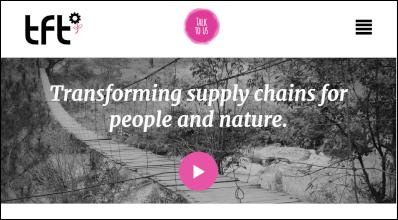
Find out more on The Forest Trust's website
The Story Of The Forest Trust
After a coffee break Scott began to tell the TFT story.
In a nutshell this consists of what TFT has learned over 17 years of struggling to deal with increasingly complex, wicked problems, in supply chains.
TFT's story begins in 1999 with Scott grappling with the challenge of removing illegally logged rain-forest timber from garden furniture supply chains. Having achieved some success in this niche, TFT moved into the significantly more complex Palm Oil business. In Palm Oil - the industry in which TFT is best known for its work - the Trust eventually managed to achieve many remarkably positive engagements, including with Nestlé and Wilmar, two of the largest players in the industry.
17 years later TFT is now working on 15 different commodities with 246 staff in 16 offices, and member companies in more than 20 countries. TFT's VT-TV process now seeks to keep an eye on values and ethics involved in an estimated $1 trillion of annual supply chain activity.
As Scott explained the complex relationships and the levers which TFT had used to improve corporate behaviour, he drew a diagram which sought to show the nature of the problems encountered when trying to eliminate deforestation, illegal logging, slavery and murder from supply chains. In doing so he illustrated the challenges faced by the conventional method for dealing with these challenges - certification schemes - which seek to outsource responsibility to inadequately resourced and easily gamed systems.
As TFT's market understanding developed it became apparent that to achieve meaningful improvements in these supply chains it was necessary to address many different parts of the market simultaneously.
By now Scott's diagram had turned into what he described as "a dogs breakfast, a complete mess."
And the underlying lesson from this? "In the end it's all about people. The places we have seen the most change happen is when the CEO and board owns its responsibility to fix its supply chain in their guts."
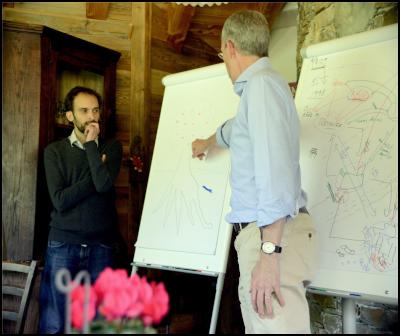
Julien and Scott presenting
Julien expanded on this idea using a frame of reference from organisational theorist Gareth Morgan concerning the levels of disagreement and uncertainty in organisations over strategy. Organisations, Julien explained, tended to want to operate in the safe places, where both disagreement and uncertainty are low. Conceptually this is called the "known" space.
But in today's rapidly evolving business world this "known" space has become a "place of death" for organisations. And when it comes to the challenge of addressing environmental degradation it is a dead zone. Over time TFT noticed much of its work involved pushing people out over the boundary of the "known" space, towards the "edge of chaos", and into the realm of the unknown. It was when they managed to do this well that magic sometimes happened. Significant lasting change and improvement for the environment had been the result.
When the process was working well - as it was now inside some of TFT's biggest member companies - the pace of change had accelerated and strengthened as the organisations had become more experienced at making decisions whilst operating in the realm of the "unknown". TFT had also learned it was only when companies were well connected to their values that they were able to begin to take this leap into the "unknown".
This final observation would later become a key theme of our gathering.

Over lunch the diggers took advantage of the cloud free skies.
A Personal Coat Of Arms
After lunch it was time to begin the process of taking the theory (TFT's story) and turn it into something we could apply to ourselves. The intention of our four days together was to take the lessons TFT had learned about organisational dynamics and apply them internally, to our deepest selves.
Our objective would be to engage our inner ducks[*], and through doing so to gain access to a deep internal reservoir of strength and resilience. [* For an introduction to the role of ducks in the work of Earthworm see this passage from the first story.]
To introduce us to this idea Scott told the story of his encounter as a child, via a radio interview with "man of the trees" Richard St Barbe Baker. This experience had become a rich source of values and inspiration for the work he later became involved with.
And then I got all the 400 children to repeat after me, all standing up in the rain. "He that planteth a tree is a servant of God. He provideth a kindness for many generations, and faces that he hath not seen, shall bless him. Good luck with your planting." And off they went to plant their trees. Those children will never forget this ceremony. – A prayer that Dr Richard St Barbe Baker was very fond of using before commencing mass tree planting efforts.
And now it was our turn.
We diggers were dispatched to draw a coat of arms for our own duck. This would consist of a visual representation, and if we wanted, a motto.
As guidance to assist us in this process of divining what our duck stands for, Julien suggested drawing a timeline of our lives, this would help us identify the times that we thought we were closest to our duck. From the results we might then be able to discern what truly makes us tick.
By now I was rearing to go. On a single A4 page I plotted my life on a vertical axis down the middle of the page.
On one side of the page I noted the significant life events, the times and events I think shaped me as well as the turning points, the times when I made significant life changing decisions. On the other side of the line I included the names of people who I felt had had a significant impact on who I am. Mostly these were people who had had a positive impact, family and friends, but there were also a few people who had had a negative impact (all of whom related to the later half of my professional life).
Perhaps helped by the build up to this gathering, or maybe by the self reflection I had been through before and during my move to Europe, I found the timeline exercise remarkably easy.
I then looked through the timeline for the moments when I felt I was closest to my true self, to my duck. I circled these moments on my piece of paper. It was immediately obvious that these moments - the times when I had felt most centered and close to to my duck - tended to also be the times I felt closest to my sense of spirituality, to my universe. I drew a winding line through these moments trying to guesstimate the extent to which I had departed from my path between my points of light.
From this timeline it was then relatively easy to determine a set of core values. What was the central context to these points of light in my life? The importance of family and friends, and the love I have received and given to both was clearly the dominant narrative. The other obvious themes were my faith and career journeys. I reflected that my faith is closely associated with hope, and my journalism career with the pursuit of truth and justice.
I then took the coat of arms instruction rather literally and produced the image below.
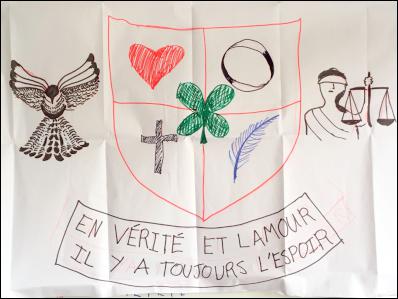
EN VÉRITÉ ET L'AMOUR , IL Y A TOUJOURS L'ESPOIR
and in English…
IN TRUTH AND LOVE THERE IS ALWAYS HOPE.
In the middle there is a four leafed clover which relates to the role of fate and luck. On the left hand side the piwakawaka (a.k.a NZ fantail) - which some may recognise as coming from Fly My Pretties IV - is symbolic both of spirits and the role of chaos. On the right hand side the scales of justice reflect my belief in the importance of justice and the rule of law in managing human affairs.
The four panels on the shield contain symbols of the core values I had decided (from the timeline exercise) represented my guiding principles. Clockwise from top left these are: friendship (heart); family (ring); truth (quill pen); and faith (cross).
It is hard to describe the feeling of satisfaction that came both from the creation of this concrete expression of what I aspire to be and who I believe I am. These are the things I think about when I decide what is the right thing to do. And it was from here that my motto quickly came together. Considering the image again now, as I write this, the firmly grounded and centered feeling returns. I recognise this direction finding duck. And then when I look for an image to illustrate this point I find this. Perfect!
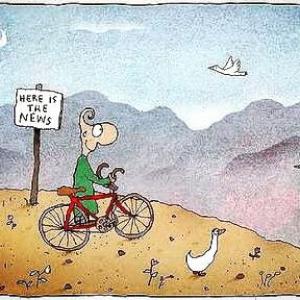
Over the remainder of our time together each digger was given time to present their coat of arms to the group, and explain it.
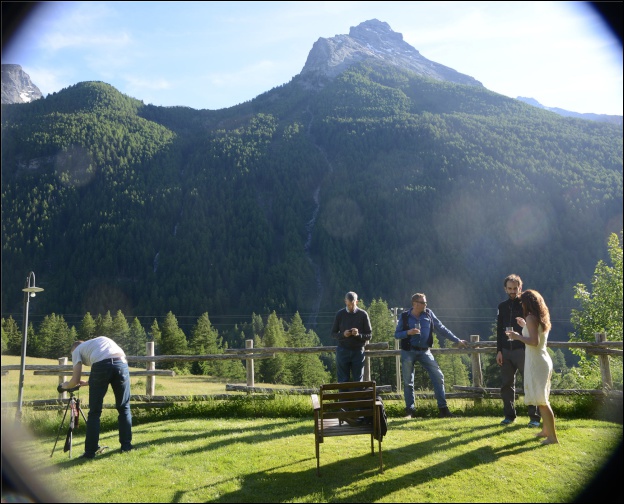
Earthworm gathering photographer Franck Vogel sets up a portrait studio on the lawn. Behind the diggers you can see Imer's Punta Pousett looming over us.
Portraits & conviviality
Following our exercise in internal duck divination, with such beautiful light striking the Plan de la Tour garden photographer Franck Vogel thought this the perfect time to shoot a series of portraits of our faithful diggers with the mountains of Gran Paradiso National Park in the background.
To reflect the professional and personal boundary which Earthworm's work is hoping to navigate, Franck took two pictures of each of us, one in work attire and a second in clothes we might wear when relaxing.
A crew was dispatched to pick up some dinner, while the rest of us enjoyed the last of the light with a bottle of wine.
We then gathered for dinner and told each other more stories.
Dinner
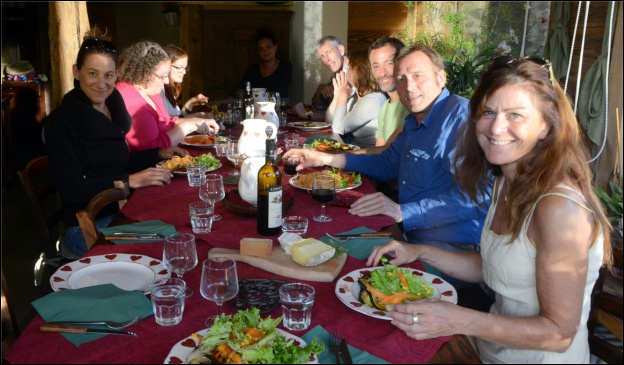
After dinner, with the benefit of some Dutch courage, I volunteered to kick off the coat of arms presentation series. The experience of revealing my duck, explaining who I thought I was and why, was also a pleasant experience. It also appeared to be a comfortable experience for my fellow diggers, Denise (left) and Milena (right) who followed.
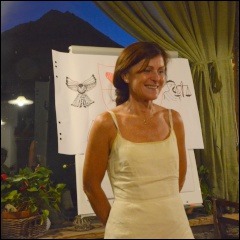
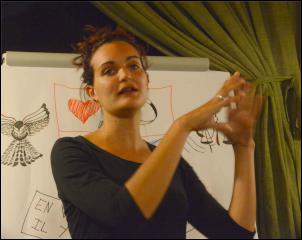
More conviviality followed - during which we were introduced to the mountain region's special liqueur - Génépi. Génépi is made by steeping the aromatic flowering tops of alpine plants of the genus Artemisia (aka wormwood).
During the discussion Scott explained a technique that he uses to help himself with the next step in the process, transparency, a key component of which is self awareness. This was what we would be working on the following day – identifying the things, including stories, that hold us back from being the person we think we are i.e. the person in our coat of arms.
The technique Scott taught us is very simple, for 10 minutes in the morning we were encouraged to simply look ourselves in the eye in a mirror. We weren't asked to think about anything in particular, but just to have an open mind and then - if we wanted to do so - report back on how it made us feel the following day.
And that’s where day one of the first Earthworm Gathering for Faithful Diggers finished. It felt like we had covered a lot and it was time for a restful sleep.
"I was searching for that elusive thing that all of us search for, most of the time we not even conscious of it. We are searching for ourselves in an authentic way. We want to recognise the person we see in the mirror. And embrace that person with all the brokenness and lacklustre. All the things that only we are aware of in the depth of our being." – From Martin Sheen's interview by NPR's Krista Tippett on the Spirituality of Imagination.
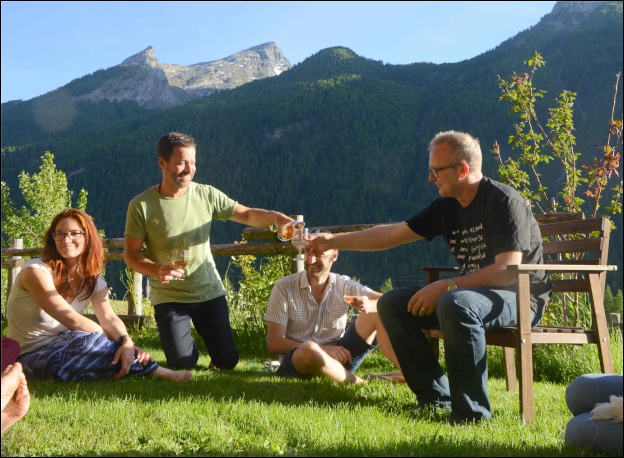
A particularly fine moment on day one of our Earthworm gathering. I am wearing a t-shirt from NZ's 2014 general election RockEnrol campaign.
 Author’s note:
Alastair Thompson is a political journalist and entrepreneur
from New Zealand who moved to Europe at the end of 2015. He
is presently freelancing in Europe and working on a number
of projects as an adviser including Earthworm. From 1999 to
2015 he was the editor and general manager of Scoop
Independent news a digital news startup which publishes the
Scoop.co.nz news website. In 2015 he led
a transformation project which vested Scoop in the ownership
of the Scoop Foundation for Public Interest Journalism.
Alastair welcomes feedback and questions at alastair@scoopmedia.co.nz
Author’s note:
Alastair Thompson is a political journalist and entrepreneur
from New Zealand who moved to Europe at the end of 2015. He
is presently freelancing in Europe and working on a number
of projects as an adviser including Earthworm. From 1999 to
2015 he was the editor and general manager of Scoop
Independent news a digital news startup which publishes the
Scoop.co.nz news website. In 2015 he led
a transformation project which vested Scoop in the ownership
of the Scoop Foundation for Public Interest Journalism.
Alastair welcomes feedback and questions at alastair@scoopmedia.co.nz


 Binoy Kampmark: Junk Science And Bad Policing - The Homicide Prediction Project
Binoy Kampmark: Junk Science And Bad Policing - The Homicide Prediction Project Keith Rankin: Rational Expectations, Intelligence, And War
Keith Rankin: Rational Expectations, Intelligence, And War Peter Dunne: Dunne's Weekly - Is Andrew Little Wellington's Mayor-In-Waiting?
Peter Dunne: Dunne's Weekly - Is Andrew Little Wellington's Mayor-In-Waiting? Gordon Campbell: On Peter Dutton’s Fading Election Prospects.
Gordon Campbell: On Peter Dutton’s Fading Election Prospects. Binoy Kampmark: Withdrawal Symptoms - Hungary, Europe And The International Criminal Court
Binoy Kampmark: Withdrawal Symptoms - Hungary, Europe And The International Criminal Court Martin LeFevre - Meditations: No Silver Lining, Just An Opening
Martin LeFevre - Meditations: No Silver Lining, Just An Opening